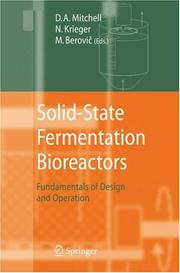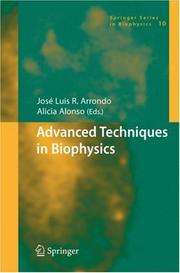| Listing 1 - 5 of 5 |
Sort by
|

ISBN: 9780824723439 0824723430 Year: 2006 Publisher: Boca Raton : Taylor & Francis,
Abstract | Keywords | Export | Availability | Bookmark
 Loading...
Loading...Choose an application
- Reference Manager
- EndNote
- RefWorks (Direct export to RefWorks)
Book
ISBN: 0131278398 Year: 2006 Publisher: Upper Saddle River, NJ : Pearson Education International,
Abstract | Keywords | Export | Availability | Bookmark
 Loading...
Loading...Choose an application
- Reference Manager
- EndNote
- RefWorks (Direct export to RefWorks)
Chemical reactors --- Chemical engineering --- Chemical reactions --- Réacteurs chimiques. --- Génie chimique. --- Réactions chimiques. --- Chemische reacties --- Reactiemechanismen --- Chemical reactors. --- Chemical kinetics. --- Chemical reactions. --- Génie chimique --- Cinétique chimique. --- Study and teaching. --- Étude et enseignement.

ISBN: 1280615044 9786610615049 3540312862 3540312854 3642068391 9783540312857 Year: 2006 Publisher: Berlin : Springer,
Abstract | Keywords | Export | Availability | Bookmark
 Loading...
Loading...Choose an application
- Reference Manager
- EndNote
- RefWorks (Direct export to RefWorks)
Although solid-state fermentation (SSF) has been practiced for many centuries in the preparation of traditional fermented foods, its application to newer products within the framework of modern biotechnology is relatively restricted. It was c- sidered for the production of enzymes in the early 1900s and for the production of penicillin in the 1940s, but interest in SSF waned with the advances in submerged liquid fermentation (SLF) technology. The current dominance of SLF is not s- prising: For the majority of fermentation products, it gives better yields and is e- ier to apply. It is notoriously difficult to control the fermentation conditions in SSF; these difficulties are already apparent at small scale in the laboratory and are exacerbated with increase in scale. However, there are particular circumstances and products for which SSF technology is appropriate. For example, a desire to reuse solid organic wastes from agriculture and food processing rather than simply discarding them leads naturally to the use of SSF. Further, some microbial pr- ucts, such as fungal enzymes and spores, amongst others, are produced in higher yields or with better properties in the environment provided by SSF systems. With recognition of this potential of SSF, a revival of interest began in the mid- 1970s. However, the theoretical base for SSF bioreactor technology only began to be established around 1990.
Bioreactors --- Solid-state fermentation. --- Design and construction. --- Solid-phase fermentation --- Fermentation --- Solid-phase biochemistry --- Biochemical reactors --- Reactors, Biochemical --- Biochemical engineering --- Chemical reactors --- Equipment and supplies --- Biochemical engineering. --- Microbiology. --- Food science. --- Chemistry, Physical organic. --- Biochemical Engineering. --- Applied Microbiology. --- Food Science. --- Physical Chemistry. --- Microbial biology --- Biology --- Microorganisms --- Chemistry, Physical organic --- Chemistry, Organic --- Chemistry, Physical and theoretical --- Science --- Bio-process engineering --- Bioprocess engineering --- Biochemistry --- Biotechnology --- Chemical engineering --- Solid-state fermentation --- 66.089 --- Biotechnologie --- Fermentatie --- Design and construction --- Food—Biotechnology. --- Physical chemistry. --- Chemistry, Theoretical --- Physical chemistry --- Theoretical chemistry --- Chemistry

ISBN: 3540307001 9783540307006 3642067980 9786610627028 1280627026 3540307869 Year: 2006 Volume: 10 Publisher: Berlin : Springer-Verlag,
Abstract | Keywords | Export | Availability | Bookmark
 Loading...
Loading...Choose an application
- Reference Manager
- EndNote
- RefWorks (Direct export to RefWorks)
Technical advancements are basic elements in our life. In biophysical studies, new applications and improvements in well-established techniques are being implemented every day. This book deals with advancements produced not only from a technical point of view, but also from new approaches that are being taken in the study of biophysical samples, such as nanotechniques or single-cell measurements. This book constitutes a privileged observatory for reviewing novel applications of biophysical techniques that can help the reader enter an area where the technology is progressing quickly and where a comprehensive explanation is not always to be found.
Biophysics. --- Biophysique --- Biophysics -- Technique. --- Biophysics --- Biological Science Disciplines --- Physics --- Natural Science Disciplines --- Disciplines and Occupations --- Biology - General --- Biology --- Health & Biological Sciences --- Technique --- Research. --- EPUB-LIV-FT LIVPHYSI SPRINGER-B --- Biological research --- Biomedical research --- Biological physics --- Physics. --- Biotechnology. --- Biochemistry. --- Cell biology. --- Biological physics. --- Biophysics and Biological Physics. --- Microengineering. --- Biochemistry, general. --- Biological Techniques. --- Cell Biology. --- Technique. --- Medical sciences --- Microreactors. --- Cytology --- Cytology. --- Biological and Medical Physics, Biophysics. --- Research --- Methodology. --- Cell biology --- Cellular biology --- Cells --- Cytologists --- Biological chemistry --- Chemical composition of organisms --- Organisms --- Physiological chemistry --- Chemistry --- Micro-chemical engineering --- Microchannel reactors --- Microfabricated reactors --- Microreaction technology --- Mini-scale reactors --- Nano-scale reactors --- Chemical reactors --- Composition --- Biology—Technique. --- Chemical engineering --- Genetic engineering

ISBN: 3540310495 3540310487 3642068219 Year: 2006 Publisher: Berlin ; New York : Springer-Verlag,
Abstract | Keywords | Export | Availability | Bookmark
 Loading...
Loading...Choose an application
- Reference Manager
- EndNote
- RefWorks (Direct export to RefWorks)
Many plants, animals, and microbes use adhesive polymers and structures to attach to inert substrates, to each other, or to other organisms. This is the first major review that brings together research on many of the well-known biological adhesives. Emphasizing the diversity of biological adhesives and associated adhesion processes, it deals with bacteria, fungi, algae, and marine and terrestrial animals. It bridges a variety of disciplines including biochemistry, molecular biology, biomechanics, bioengineering, microbiology, organism structure and function, and ultrastructure. As we learn more about the molecular and mechanical properties of these adhesives, we begin to understand why they adhere so well and how they develop cohesive strength. With this understanding comes the prospect of developing synthetic or semi-synthetic adhesives with broad applications in areas such as medicine, dentistry, and biotechnology. The book is suitable for both industrial and academic researchers.
Adhesion. --- Adhesives. --- Cell adhesion molecules. --- Cell adhesion. --- Adherence, Cell --- Cell adherence --- Adhesion --- Cell interaction --- Membrane fusion --- Junctional complexes (Epithelium) --- Adhesion molecules (Cytology) --- Adhesion substances (Cytology) --- Cell adhesion substances --- Intercellular adhesion molecules --- Morphoregulatory molecules --- Biomolecules --- Desmosomes --- Hemidesmosomes --- Agglutinants --- Bonding agents (Adhesives) --- Binders (Materials) --- Cement --- Cements, Adhesive --- Glue --- Mucilage --- Adsorption --- Cohesion --- Biochemistry. --- Microreactors. --- Biotechnology. --- Biomaterials. --- Microbiology. --- Biochemistry, general. --- Microengineering. --- Biological and Medical Physics, Biophysics. --- Microbial biology --- Biology --- Microorganisms --- Biocompatible materials --- Biomaterials --- Medical materials --- Medicine --- Biomedical engineering --- Materials --- Biocompatibility --- Prosthesis --- Chemical engineering --- Genetic engineering --- Micro-chemical engineering --- Microchannel reactors --- Microfabricated reactors --- Microreaction technology --- Mini-scale reactors --- Nano-scale reactors --- Chemical reactors --- Biological chemistry --- Chemical composition of organisms --- Organisms --- Physiological chemistry --- Chemistry --- Medical sciences --- Composition --- Biophysics. --- Biological physics. --- Bioartificial materials --- Hemocompatible materials --- Biological physics --- Physics --- Biomaterials (Biomedical materials)
| Listing 1 - 5 of 5 |
Sort by
|

 Search
Search Feedback
Feedback About UniCat
About UniCat  Help
Help News
News